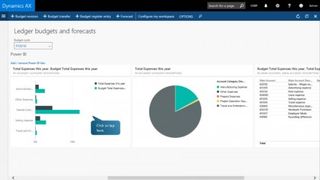Dynamics AX is switching to be a cloud service on Azure – or Azure Stack
Microsoft is now using Azure Stack as a way to bring SaaS on-premise
Not all Microsoft cloud services
The plan is to have "one Azure ecosystem" but Microsoft has already said that not all Azure services will come to Azure Stack. "Should all services make the transition? There are going to be trade-offs and saying you can take a copy of all of Azure doesn't necessarily make sense," explains Ryan O'Hara from the Azure team. "There are some services where customers benefit from the shared tenancy model, operated at great scale."
The Azure IoT services in particular are set up to deal with streams of data from large numbers of devices and it would take a lot of hardware to run that yourself. "Does an IoT customer want to have the Azure IoT Suite on premise?" questioned Mike Neil, the corporate VP of Microsoft's enterprise cloud group when Azure Stack was announced.
"Right now," he said then, "our thinking is we're drawing a line at PaaS services and probably not bringing SaaS services on-premises." Instead, it would be easy to run the server versions of Microsoft software on Azure Stack – he said "what we'll provide is the resources so you can deploy SQL Server as a template, you can deploy SharePoint as a template". But he also noted "technically, there isn't anything that would prevent this."
Russinovich also suggested that some Microsoft cloud services – including Office 365 – simply wouldn't be ready to run on Azure Stack. "Office 365 has grown up independent of Azure – we're in the middle of a migration to Azure now, but it's probably not something that would be ready any time soon if we did decide we wanted to do it."
Instead, he predicted developers would use the Azure Resource Manager template system that's in Azure Stack and public Azure to make it easy to get new SaaS services designed to run on both. "I think what you will see is a SaaS ecosystem start to build up around that, so you'll see new SaaS apps that can come down to Azure Stack."
Because the Dynamics team was ready to completely rebuild Dynamics AX for Azure, they've already done a lot of the work necessary to make it run on Azure Stack. And while Salesforce shows that businesses are very happy to put their CRM in the cloud, some companies may be less comfortable about having the financial information in their ERP system there, so an on-premise version is still important – and Azure Stack is the way Microsoft is trying to square that cloud circle.
Of all Microsoft's cloud services, Dynamics AX is the most logical to see on Azure Stack, but it also opens the possibility that more of Microsoft's SaaS offerings that are built on Azure (probably those that have launched more recently, like Power BI) could be available on Azure Stack in future.
Are you a pro? Subscribe to our newsletter
Sign up to the TechRadar Pro newsletter to get all the top news, opinion, features and guidance your business needs to succeed!

When Azure Stack ships
Although Dynamics AX 7 is available now on Azure, if you need to upgrade from an earlier version – which really means extracting all your data and business processes from whatever version of Dynamics AX you use and moving them to the cloud service – you'll have to wait a little longer.
Migration from Dynamics AX R3 will be possible later this year, and migration from Dynamics AX 2009 should be available this autumn. But because Dynamics 2012 customers will only recently have installed their systems Microsoft doesn't expect them to be in a hurry to move, so the tools for that will come next year. And you'll have to wait that long to have Dynamics on your own hardware.
In the launch chat, one of the Dynamics team also let slip the planned date for when Dynamics AX will launch on Azure Stack. We already knew from Microsoft's licensing FAQ that Windows Server 2016 (which Azure Stack is built on) will be commercially available in Q3 of 2016. Now we also know that Azure Stack will come at the end of the year.
"The Azure Stack release is slated for December 2016," said Arif Kureshy, the development manager for Dynamics. "Once that is released, [we] will provide a timeline for on-premise."
Mary (Twitter, Google+, website) started her career at Future Publishing, saw the AOL meltdown first hand the first time around when she ran the AOL UK computing channel, and she's been a freelance tech writer for over a decade. She's used every version of Windows and Office released, and every smartphone too, but she's still looking for the perfect tablet. Yes, she really does have USB earrings.
Most Popular


